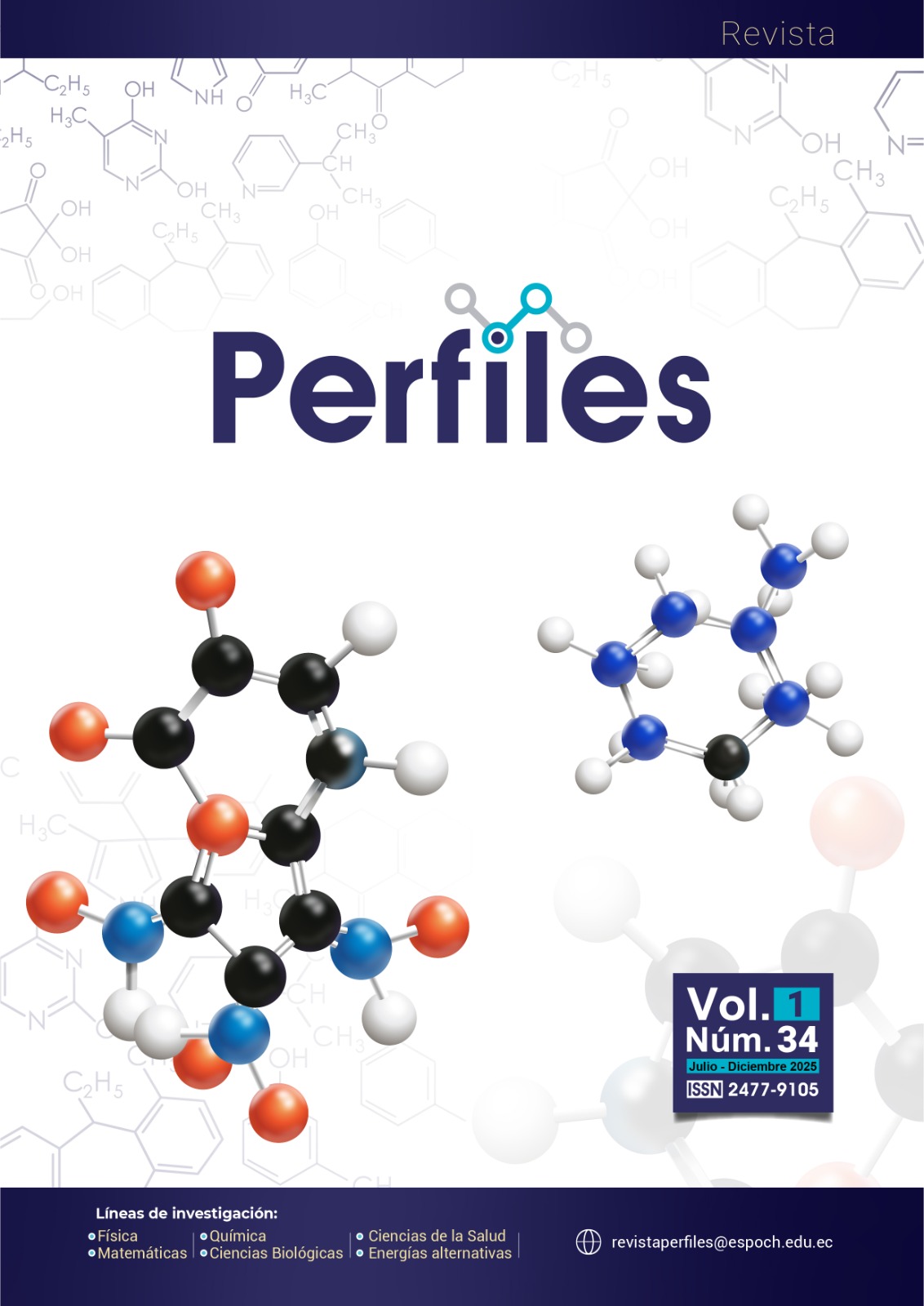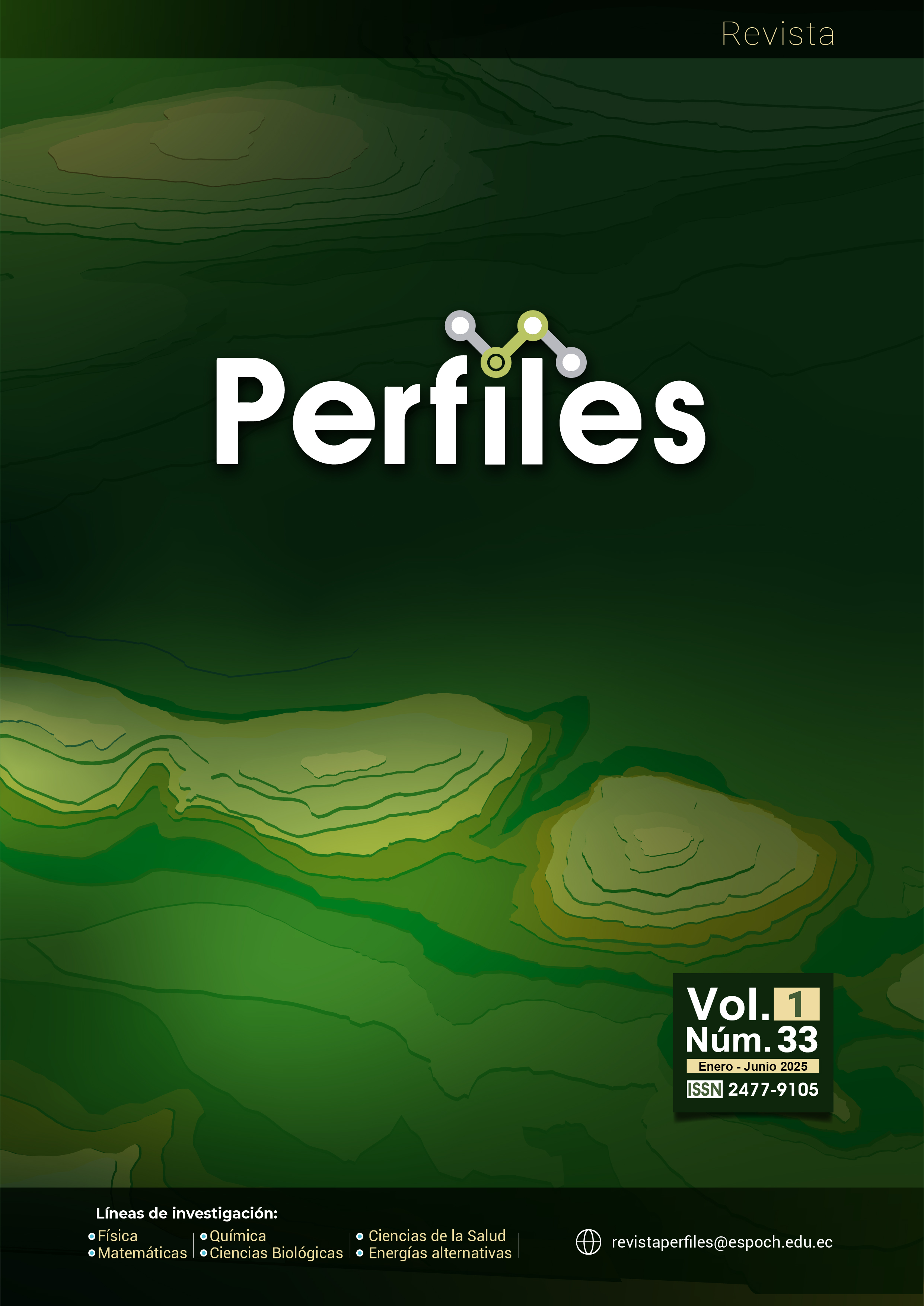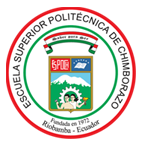Mathematical modeling of the extraction process of bioactive compounds from shrimp (Litopenaeus vannamei) waste
DOI:
https://doi.org/10.47187/perf.v1i34.348Keywords:
Astaxanthin, shrimp waste, extraction kineticsAbstract
Astaxanthin is a carotenoid with important biological activity, even with greater antioxidant activity than other carotenoids. There are restrictions regarding the use of synthetics compounds, so there is interest in obtaining this carotenoid from natural sources. This compound is responsible for the characteristic pinkish color of shrimp, and shrimp farming has increased globally, however, so have the negative effects associated with this activity, mainly the generation of waste, which constitutes approximately 25-60% by weight of this crustacean.
Considering this aspect, the present study evaluated the obtaining and modelling the of astaxanthin extraction kinetics from shrimp shells (Litopenaeus vannamei) using the Soxhlet. Shrimp residues were characterized by proximal analysis, particle size and shape. The overall extraction yields, as well as the astaxanthin content were evaluated by gravimetric and spectrophotometric methods. The highest overall yield of the extraction process was obtained for the solvent ethanol+water (3.75%) and the highest concentration of astaxanthin was for solvents ethanol and methanol (292.2 and 296.0μg/g respectively). The model that presented the best fit to describe the extraction kinetics was the Peleg model, with a coefficient of determination varying between 0.93 and 0.98. The present research demonstrates the potential recovery of astaxanthin from shrimp waste, using ethanol.
Downloads
References
Hu J, Lu W, Lv M, Wang Y, Ding R, Wang L. Extraction and purification of astaxanthin from shrimp shells and the effects of different treatments on its content. Rev Bras Farmacogn. 2019;29(1):24–29.
Ravishankar G, Rao R, editors. Global Perspectives on Astaxanthin: From Industrial Production to Food, Health, and Pharmaceutical Applications. London: Elsevier Academic Press; 2021.
Pond Tech. Astaxanthin is Nature’s Strongest Antioxidant [Internet]. 2019 [cited 2024 Feb 28]. Available from: https://pondtech.com/astaxanthin/
Transparency Market Research. Astaxanthin Market Size – Global Industry Report 2022–2032 [Internet]. 2019 [cited 2024 Feb 28]. Available from: https://www.transparencymarketresearch.com/astaxanthin-market.html
Cheong J, Muskhazli M. Turning leftover to treasure: An overview of astaxanthin from shrimp shell wastes. In: Ravishankar G, Rao R, editors. Global Perspectives on Astaxanthin: From Industrial Production to Food, Health, and Pharmaceutical Applications. London: Elsevier Academic Press; 2021. p. 253–279.
Morales-Carvajal J, Villabona-Nuncira R, Gonzalez-Delgado D, Barajas-Ferreira C, Barajas-Solano A. Technical-economic prefeasibility study of astaxanthin production system from H. pluvial microalgae in Colombia [Internet]. Indian J Sci Technol. 2018 Sep 5;11(34):1–8 [cited 2024 Feb 28]. Available from: https://indjst.org/articles/technical-economic-prefeasibility-study-of-astaxanthin-production-system-from-h-pluvial-microalgae-in-colombia
Orbis Research. Astaxanthin Market to Grow at 2.4% CAGR to hit $91 million [Internet]. 2019 [cited 2024 Feb 28]. Available from: https://www.globenewswire.com/news-release/2019/06/19/1871148/0/en/Astaxanthin-Market-to-Grow-at-2-4-CAGR-to-hit-91-million-by-2025-Global-Analysis-by-Size-Demand-Trends-Top-10-Players-Sales-Revenue-and-Growth-Forecast-Orbis-Research.html
Panis G, Carreon J. Commercial astaxanthin production derived by green alga Haematococcus pluvialis: A microalgae process model and a techno-economic assessment all through production line. Algal Res. 2016 Sep 1;18:175–190.
Industry-experts. Global Astaxanthin Market Size, Outlook 2024–2030 [Internet]. 2015 [cited 2024 Feb 28]. Available from: https://industry-experts.com/verticals/nutraceuticals/global-astaxanthin-market-sources-technologies-and-applications
Nguyen K. Astaxanthin: A comparative case of synthetic vs natural production [Internet]. Chem Biomol Eng. 2013 Jan 1;52(4):772–788 [cited 2024 Feb 28]. Available from: https://trace.tennessee.edu/utk_chembiopubs/94
Boyd C, Davis R, Wilson A, Marcillo F, Brian S, McNevin A. Resource use in whiteleg shrimp Litopenaeus vannamei farming in Ecuador [Internet]. J World Aquac Soc. 2021 Aug 1;52(4):772–788 [cited 2024 Feb 28]. Available from: https://onlinelibrary.wiley.com/doi/full/10.1111/jwas.12818
Alarcon A. Proyecto de prefactibilidad, para la exportación de harina de cabeza de camarón de cultivo hacia Colombia para la elaboración de un sazonador en la ciudad de Medellín período 2013–2018 [Bachelor thesis] [Internet]. Quito: UTE; 2014 [cited 2024 Feb 28]. Available from: https://repositorio.ute.edu.ec/entities/publication/34ac828f-c2e3-4110-a6a6-e4d53201e278
La Hora. Cáscara de camarón reduce el impacto de curtiembres [Internet]. 2018 [cited 2024 Feb 28]. Available from: https://www.lahora.com.ec/archivo/Cascara-de-camaron-reduce-el-impacto-de-curtiembres-20181024-0097.html
Alvarado F. Análisis de factibilidad de la exportación de cáscaras de camarón como materia prima para la industria farmacéutica china: Investigación de mercado [Bachelor thesis] [Internet]. Guayaquil: Univ. Casa Grande; 2013 [cited 2024 Feb 28]. Available from: https://dspace.casagrande.edu.ec/items/412f549d-beba-4f33-8f91-95878180fe82
Armenta-López R, Guerrero L, Huerta S. Astaxanthin extraction from shrimp waste by lactic fermentation and enzymatic hydrolysis of the carotenoprotein complex [Internet]. J Food Sci. 2002 Apr 1;67(3):1002–1006 [cited 2024 Feb 28]. Available from: https://onlinelibrary.wiley.com/doi/full/10.1111/j.1365-2621.2002.tb09443.x
Dalei J, Sahoo D. Extraction and characterization of astaxanthin from the crustacean shell waste from shrimp processing industries [Internet]. IJPSR. 2015 Jun 1;6(6):2532–2537 [cited 2024 Feb 28]. Available from: https://ijpsr.com/bft-article/extraction-and-characterization-of-astaxanthin-from-the-crustacean-shell-waste-from-shrimp-processing-industries/
Crank J, McFarlane N, Newby J, Paterson G, Pedley J. Diffusion processes in environmental systems [Internet]. Salisbury: Macmillan; 1981. 160 p. [cited 2024 Feb 28]. Available from: https://books.google.com/books/about/Diffusion_Processes_in_Environmental_Sys.html?id=4dJyQgAACAAJ
Lopez G, Brousse M, Vergara M, Gonzalez A, Cruz N, Linares R. Cinética de extracción acuosa de compuestos fenólicos a partir de hojas de yerba mate elaborada [Internet]. Rev Cienc Tecnol. 2021 Nov 15;36(1):30–38 [cited 2024 Feb 28]. Available from: https://www.fceqyn.unam.edu.ar/recyt/index.php/recyt/article/view/690/680
Yiğitarslan S. Modeling of solid-liquid extraction of total phenolics from Capsicum annum L. J Turk Chem Soc Sect B Chem Eng [Internet]. 2017;1(1):43–60 [cited 2024 Feb 28]. Available from: https://dergipark.org.tr/en/pub/jotcsb/issue/31518/345317
Yulianto ME, Jos B, Budiyono B. Kinetic modelling of liquid-solid extraction of bioactive compounds from ginger waste using subcritical water [Internet]. JST. 2023 Jun 16;21(1):28–35 [cited 2024 Feb 28]. Available from: https://journal.unnes.ac.id/nju/sainteknol/article/view/44589
AOAC International. Official Methods of Analysis [Internet]. 22nd ed. Gaithersburg: AOAC International; 2023 [cited 2024 Feb 28]. Available from: https://www.aoac.org/official-methods-of-analysis/
Gomide R. Operações Unitárias, Vol. 1 Operações com Sistemas Sólidos Granulares [Internet]. São Paulo: Câmara Brasileira do Livro; 1983 [cited 2024 Feb 28]. Available from: https://archive.org/details/reynaldo-gomide-operacoes-unitarias-vol.-1-operacoes-com-sistemas-solidos-granul
da Silva A, Rodrigues B, da Silva L, Rodrigues A. Drying and extraction of astaxanthin from pink shrimp waste (Farfantepenaeus subtilis): the applicability of spouted beds [Internet]. Food Sci Technol. 2018 Jul 30;38(3):454–461 [cited 2024 Feb 28]. Available from: https://www.scielo.br/j/cta/a/XBxk3fsmhCrJDg6zLX9TwgB/?lang=en
Cadena-Carrera S. Avaliação da atividade biológica in vitro de extratos obtidos de folhas de guayusa (Ilex guayusa L.) por técnicas a baixa e alta pressão [PhD thesis] [Internet]. Florianopolis: Universidade Federal de Santa Catarina; 2019 [cited 2024 Feb 28]. Available from: https://repositorio.ufsc.br/handle/123456789/215409
Tramontin D, Cadena-Carrera S, Bella-Cruz A, Bella Cruz C, Bolzan A, Quadri M. Biological activity and chemical profile of Brazilian jackfruit seed extracts obtained by supercritical CO2 and low pressure techniques [Internet]. J Supercrit Fluids. 2019 Oct 1;152:104551 [cited 2024 Feb 28]. Available from: https://www.sciencedirect.com/science/article/abs/pii/S0896844619302001
Musa K, Abdullah A, Jusoh K, Subramaniam V. Antioxidant activity of pink-flesh guava (Psidium guajava L.): effect of extraction techniques and solvents [Internet]. Food Anal Methods. 2011 Mar 1;4(1):100–107 [cited 2024 Feb 28]. Available from: https://link.springer.com/article/10.1007/s12161-010-9139-3
Simeonov E, Yaneva Z, Chilev C. Kinetics of green solid-liquid extraction of useful compounds from plant materials: kinetics coefficients and modeling [Internet]. Green Process Synth. 2018 Feb 23;7(1):68–73 [cited 2024 Feb 28]. Available from: https://www.degruyterbrill.com/document/doi/10.1515/gps-2016-0179/html
Winitsorn A, Douglas P, Douglas S, Pongampai S, Teppaitoon W. Modeling the extraction of valuable substances from natural plants using solid–liquid extraction [Internet]. Chem Eng Commun. 2008 Nov;195(11):1457–1468 [cited 2024 Feb 28]. Available from: https://www.tandfonline.com/doi/abs/10.1080/00986440801967288
Agu C, Menkiti M, Ohale PE, Ugonabo V. Extraction modeling, kinetics, and thermodynamics of solvent extraction of Irvingia gabonensis kernel oil, for possible industrial application [Internet]. Eng Rep. 2021 Apr 1;3(4):e12306 [cited 2024 Feb 28]. Available from: /doi/pdf/10.1002/eng2.12306
Honarvar B, Sajadian S, Khorram M, Samimi A. Mathematical modeling of supercritical fluid extraction of oil from canola and sesame seeds [Internet]. Braz J Chem Eng. 2013 Jan;30(1):159–166 [cited 2024 Feb 28]. Available from: https://www.scielo.br/j/bjce/a/jVxnChVNJtm4yx6BSDrQnCz/
Karacabey E, Bayindirli L, Artik N, Mazza G. Modeling solid–liquid extraction kinetics of trans-resveratrol and trans-ε-viniferin from grape cane [Internet]. J Food Process Eng. 2013 Feb 1;36(1):103–112 [cited 2024 Feb 28]. Available from: /doi/pdf/10.1111/j.1745-4530.2011.00660.x
Almohasin J, Balag J, Miral V, Moreno R, Tongco L, Lopez E. Green solvents for liquid–liquid extraction: recent advances and future trends [Internet]. Eng Proc. 2023 Nov 15;56(1):174 [cited 2024 Feb 28]. Available from: https://www.mdpi.com/2673-4591/56/1/174/htm
Downloads
Published
How to Cite
Issue
Section
License

This work is licensed under a Creative Commons Attribution-NonCommercial 4.0 International License.


























